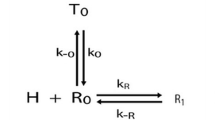Abstract
Contacts between the cell surface and extracellular substances such as peptide hormones or antigens are of prime importance in the activation of target cells and the triggering of a defined biological response, for example antibody production in sensitized lymphocytes. Similar contacts are important in intercellular communication and play an integral role in the complex differentiative processes associated with embryogenesis and tissue reorganization. The cell surface must display a large variety of complementary sites that are recognized by other cells and by biologically active effector substances.
Access this chapter
Tax calculation will be finalised at checkout
Purchases are for personal use only
Preview
Unable to display preview. Download preview PDF.
Similar content being viewed by others
References
BANG, F.B. (1972). Specificity of viruses for tissues and hosts. In:Microbial pathogenicity in wan and animals. (Smith, H. and Pearce, J.H., Eds.). 22nd Symp. Soc. Gen. Microbiol., 415–419.
BENNET, V., O’KEEFE, E. and CUATRECASAS, P. (1975). Mechanism of action of cholera toxin and the mobile receptor theory of hormone-receptor-adenylate cyclase interactions. Proc. natn. Acad. Sci. U.S.A., 72, 33–37.
BOULANGER, P.A., HOUDRET, N., SHARFMAN, A. and LEMAY, P. (1972). The role of sialic acid in adenovirus adsorption. J. gen. Virol., 16, 429–434.
BUTTERS, T.D. and HUGHES, R.C. (1975). Solubilization and fractionation of glycoproteins and glycolipids of KB cell membranes. Biochem. J., 140, 469–478.
BUTTERS, T.D. and HUGHES, R.C. Unpublished results.
CUATRECASAS, P. (1973). Interaction of Vibrio cholerae enterotoxin with cell membranes. Biochemistry, N.Y., 12, 3547–3558.
CUATRECASAS, P. (1973). Gangliosides and membrane receptors for cholera toxin. Biochemistry, N.Y., 12, 3558–3566.
CUATRECASAS, P. (1974). Membrane receptors. A. Rev. Biochem., 43, 169–214.
DALES, S. (1973). Early events in cell-animal virus interactions. Bacteriol. Rev., 37, 103–135.
GOTTLIEB, G., SKINNER, A.M. and KORNFELD, S. (1974). Isolation of a clone of Chinese hamster ovary cells deficient in plant lectin binding sites. Proc. natn. Acad. Sci., U.S.A., 71, 1078–1082.
GOTTSCHALK, A., BELYAVIN, G. and BIDDLE, F. (1973). Glycoproteins as influenza virus haemagglutinin inhibitors and as cellular virus receptors. In: Glycoproteins; their composition, structure and function. (Gottschalk, A., Ed.). Part B, 1082–1096. Elsevier Publishing Co., Amsterdam, London and New York.
HOLLand, J.J. (1964). Viruses in animals and in cell culture. In: Microbial behaviour, ‘in vivo’ and ‘in vitro’. (Smith, H. and Taylor, J., Eds.). 14th Symp. Soc. gen. Microbiol., 257–271.
HUGHES, R.C. (1973). Glycoproteins as components of cellular membranes. Prog. Biophys. mol. Biol., 26, 189–268.
HUGHES, R.C. and MAUTNER, V. (1972). Interaction of adenovirus with host cell membranes. In: Membrane mediated information. (Kent, P., Ed.). Vol. I, 104–125. Medical and Technical Publishing Co. Ltd., Lancaster.
HYMAN, R., LOCORBIERE, M., STAVEREK, S. and NICOLSON, G.L. (1974). Derivation of lymphama variants with reduced sensitivity to plant lectins. J. Nat. Cancer Inst., 52, 963–969.
MEAGER, A., BUTTERS, T.D., MAUTNER, V. and HUGHES, R.C. (1975). Interactions of KB cell glycoproteins with an adenovirus capsid protein. Eur. J. Biochem. (In press).
MEAGER, A., UNGKITCHANUKIT, A., NAIRN, R. and HUGHES, R.C. (1975). Ricin resistance in baby hamster kidney cells. Nature, Lond., 257, 137–139.
NICOLSON, G.L. (1974). The interaction of lectins with animal cells. Int. Rev. Cytol., 39, 89–190.
NORRBY, E. (1969). The structural and functional diversity of adenovirus capsid components. J. gen. Virol., 5, 221–236.
PAPPENHEIMER, A.M. and GILL, D.M. (1973). Diphtheria. Science, N.J., 182, 353–358.
PEPPER, D.S. (1964). The sialic acids of horse serum with special reference to their virus inhibitory properties. Biochim. biophys. Acta, 156, 317–326.
PETERSON, O.H. (1974). Cell membrane permeability change: an important step in hormone action. Experimenta, 30, 1105–1107.
PHILIPSON, L., LONBERG-HOLM, K. and PETERSON, U. (1969). Virus-receptor interaction in an adenovirus system. J. Virol., 2, 1064–1075.
RAPIN, A.M.C. and KALCKAR, H.H. (1971). The relation of bacteriophage attachment to lipopolysaccharide structure. In: Microbiol Toxins. Vol. IV. Bacterial Endotoxins. (Weinbaum, G., Kadis, S. and Ajl, S. J., Eds.), 267–307. Academic Press, New York and London.
REFSNES, K., OLSNES, S. and PIHL, A. (1974). On the toxic proteins ricin and abrin. Studies of their binding to and entry into Ehrlich ascites cells. J. biol. Chem., 249, 2557–3562.
SCHLESINGER, R.W. (1969). Adenoviruses: the nature of the virion and of controlling factors in productive or abortive infection and tumorigenesis. Adv. Virus Res., 14, 1–61.
SIMPSON, L.L. and RAPPORT, M.M. (1971). Ganglioside inactivation of botulinum toxin. J. Neurochem., 18, 1341–1343.
SPRINGER, G.F., SCHWICH, H.G. and FLETCHER, M.A. (1969). The relationship of the influenza virus inhibitory activity of glycoproteins to their molecular size and sialic acid content. Proc. natn. Acad. Sci., U.S.A., 64, 634–641.
STECK, T.L. (1974). The organization of proteins in the human red blood cell membrane. J. Cell Biol., 62, 1–19.
SUTTAJIT, M. and WINZLER, R.J. (1971). Effect of modification of N-acetyl neuraminic acid on the binding of glycoproteins to influenza virus and in susceptibility to cleavage by neuraminidase. J. biol. Chem., 246, 3398–3404.
VAN HEYNINGEN, S. (1974). Cholera Toxin: interaction of subunits with ganglioside GMI. Science, N.Y., 183, 656–657.
VAN HEYNINGEN, S.E. and MELLANBY, J. (1968). The effect of cerebroside and other lipids on the fixation of tetanus toxin by gangliosides. J. gen. Microbiol., 52, 447–454.
VAN HEYNINGEN, W.E., CARPENTER, W.C., PIERCE, N.F. and GREENOUGH, W.B. (1971). Deactivation of cholera toxin by ganglioside. J. infect. Dis., 124, 415–419.
WINZLER, R.J. (1970). Carbohydrates in cell surfaces. Int. Rev. Cytol., 23, 77–125.
Author information
Authors and Affiliations
Editor information
Editors and Affiliations
Rights and permissions
Copyright information
© 1976 Plenum Press, New York
About this chapter
Cite this chapter
Hughes, C. (1976). Cell Surface Membranes of Animal Cells as the Sites of Recognition of Infectious Agents and other Substances. In: Wood, R.K.S., Graniti, A. (eds) Specificity in Plant Diseases. NATO Advanced Study Institutes Series, vol 10. Springer, Boston, MA. https://doi.org/10.1007/978-1-4684-2769-1_6
Download citation
DOI: https://doi.org/10.1007/978-1-4684-2769-1_6
Publisher Name: Springer, Boston, MA
Print ISBN: 978-1-4684-2771-4
Online ISBN: 978-1-4684-2769-1
eBook Packages: Springer Book Archive




